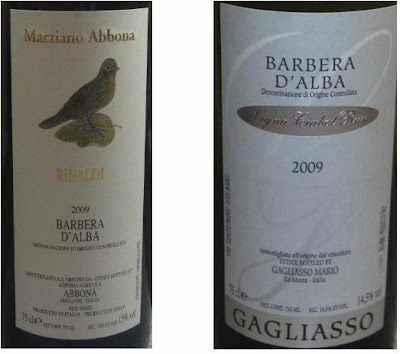We're still working through our case of Barberas that we purchased in order to convince ourselves that we want to grow Barbera as one of our red varieties. We recently had two 2009 Barbera d'Albas, one was the Marziano Abbona Rinaldi and the other was
Gagliasso Barbera d'Alba Vigna Ciabot Russ 2009.
How the wine is made:
For the Marziano Abbona Rinaldi the fermentation goes on for 5-6 days in macerators at the temperature of 28-30°C in steel tanks. The wine is then aged for 4 months in the steel tanks, 8 months in 500L tonneaux and 6 months of bottle aging.
For the Gagliasso Barbera d'Alba Vigna Ciabot Russ, the fermentation took place in temperature controlled stainless steel vats with temperatures around 28°C, 6-8 days of maceration with malolactic fermentation occurring spontaneously in the stainless steel vats. The wine is aged for 6 month in stainless steel vats, then the wine is bottled and aged for 6 months.
We had both with some kind of dish consisting of tomato sauce (pizza and spaghetti) and it paired very well. The Barberas that we have been tasting this fall have been consistently delicious, but for our palates, one that has risen above this crowd is the 2009 G.D. Vajra Barbera d'Alba.

Keep in mind the penchant of Italian winemakers not to be concerned with pH of the must. I've seen must come in at 3.8 and the senior winemaker was completely unfazed. Made in New World style the wines were significantly different. Suggest that if you are to grow these varieties that a vintage in Italy will be a good investment.
ReplyDeleteThank you for your comments on the blog. My husband and I would love to spend a vintage in Italy to learn Barbera winemaking. Do you have any suggestions?
ReplyDeleteThe simplest way is to use the network of the university - connecting to an Italian university in the region of your choice. Being the proud owners of a vineyard really does narrow down opportunities (i.e., time), so you need to be put in touch with a series of growers who cover the spectrum of growing Barbera - "traditional" through to "new style". Then to work a vintage ... again the best contacts would come through that network.
DeleteOn the other hand, many m,any young people come out to work as "interns" in New World wineries - so yet another point of contact. Many of them come from winemaking families. The exchange of goodwill and knowledge, to and fro, is an excellent thing.
As per my post on your October 2012 post - re hanging cane training, I still think that this is worthy of a look at.
Thank you for your excellent suggestions regarding Barbera winemaking. On the topic of vine training, the vineyards in our area are all VSP so we were of a mindset to do VSP ourselves, but I will look into the hanging cane training as you suggested. Thank you so much.
ReplyDeleteEverything here is VSP too. Hanging cane used in Australia and not often here. Most growers look over the fence, see that their neighbour is successful and do it that way. Dick Smart has spent a lifetime getting people to think out of the box - with only Smart-Dyson as having a degree of acceptance.
ReplyDeleteHere, Scott-Henry (also at Smart's promotion) is used, but in both cases (S-D and S-H), in humid seasons there is increased botrytis outbreaks as the canopy surrounds the crop and impedes air-flow. I have visited Virginia - where even in winter, I found the humidity high (naturally, in the colder air).
Conversion from Guyot Simple or Guyot Double, is quite easy - perhaps a row or two as a trial?